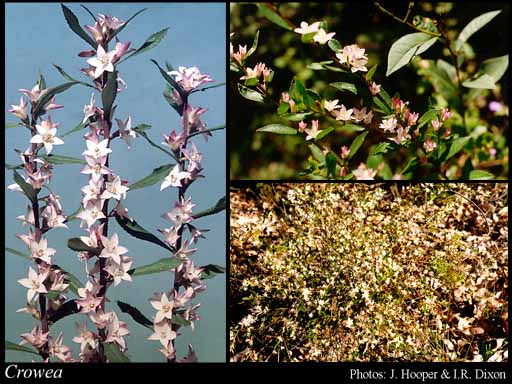- Reference
- Trans.Linn.Soc.London,Bot. 4:222 (1798)
- Name Status
- Current







Scientific Description
Family Rutaceae.
Habit and leaf form. Shrubs, or herbs; evergreen, or deciduous; bearing essential oils. Woody perennial. Young stems angled, sometimes with decurrent leaf-bases. Mesophytic, or xerophytic. Leaves alternate; chartaceous, glabrous; petiolate; non-sheathing; gland-dotted; aromatic; simple (more or less flat). Leaf blades dissected, or entire; when simple/dissected pinnatifid, or much-divided; pinnately veined, or one-veined. Leaves without stipules, or with stipules. Stipules when present, intrapetiolar; represented by glands. Leaves without a persistent basal meristem. Stem anatomy. Nodes unilacunar, or tri-lacunar. Secondary thickening developing from a conventional cambial ring.
Reproductive type, pollination. Fertile flowers hermaphrodite. Unisexual flowers absent. Plants hermaphrodite. Entomophilous.
Inflorescence and flower features. Flowers solitary; axillary, or terminal (to a short branch); bracteate; bracteolate (several towards base of pedicel); small to medium-sized; fragrant; regular, or somewhat irregular. The floral asymmetry when noticeable, involving the perianth and involving the androecium (not K). Flowers 5 merous; cyclic. Floral receptacle developing a gynophore (associated with the disk), or with neither androphore nor gynophore. Free hypanthium absent. Hypogynous disk present (a narrow lobed margin around ovary); intrastaminal; annular (sometimes one-sided), or of separate members. Perianth with distinct calyx and corolla; 10; 2 -whorled; isomerous. Calyx 5; 1 -whorled; polysepalous; imbricate; regular; with the median member posterior. Corolla 5; 1 -whorled; polypetalous; imbricate; regular, or unequal but not bilabiate; glabrous abaxially; glabrous adaxially. Androecium 10. Androecial members free of the perianth; all equal, or markedly unequal; free of one another; 1 -whorled, or 2 -whorled. Stamens 10; diplostemonous; pyramidally arranged. Filaments linear. Anthers dorsifixed (by a firm attachment to the filament-apex); versatile; dehiscing via longitudinal slits; introrse, or latrorse; tetrasporangiate; appendaged (thecae sparsely pilose and produced into a lanceolate, densely bearded appendage 2–3 mm long). Gynoecium 5 carpelled (glabrous). The pistil when syncarpous, 5 celled. Gynoecium apocarpous, or syncarpous (? carpels more or less free, embedded in disc); eu-apocarpous, or semicarpous, or synstylous; superior. Carpel apically stigmatic; (when apo- or semicarpous) (1–)2–100 ovuled. Placentation of the free carpels marginal. Ovary plurilocular; when syncarpous, 5 locular. Styles 1, or 3–5; free, or partially joined; apical (styles affixed near apex of inner margin of carpels, ovary without a sterile apex); short. Stigmas 1 - lobed; globular; wet type, or dry type; papillate, or non-papillate; Group II type, or Group IV type. Placentation when syncarpous, axile. Ovules 1–5(–50) per locule; pendulous to ascending; epitropous; when two or more per cell, collateral, or superposed, or biseriate; arillate, or non-arillate; anatropous, or hemianatropous.
Fruit and seed features. Fruit fleshy, or non-fleshy; an aggregate, or not an aggregate. The fruiting carpels coalescing into a secondary syncarp, or not coalescing. The fruiting carpel dehiscent, or indehiscent; (when apocarpous) a follicle, or drupaceous, or baccate. Fruit (when syncarpous) dehiscent, or indehiscent, or a schizocarp. Mericarps when schizocarpic, comprising berrylets, or comprising follicles, or comprising nutlets, or comprising drupelets. Fruit when syncarpous and non-schizocarpic, a berry, or a drupe. Seeds endospermic, or non-endospermic. Embryo well differentiated. Cotyledons 2. Embryo chlorophyllous, or achlorophyllous; straight, or curved, or bent. Seedling. Germination phanerocotylar, or cryptocotylar.
Physiology, biochemistry. Aluminium accumulation not found. Photosynthetic pathway: C3.
Geography, cytology, number of species. N=19. A genus of 3 species.
Taxonomic Literature
- Wheeler, Judy; Marchant, Neville; Lewington, Margaret; Graham, Lorraine 2002. Flora of the south west, Bunbury, Augusta, Denmark. Volume 2, dicotyledons. Australian Biological Resources Study.. Canberra..
- Grieve, B. J.; Blackall, W. E. 1998. How to know Western Australian wildflowers : a key to the flora of the extratropical regions of Western Australia. Part II, Dicotyledons (Amaranthaceae to Lythraceae). University of W.A. Press.. Nedlands, W.A..